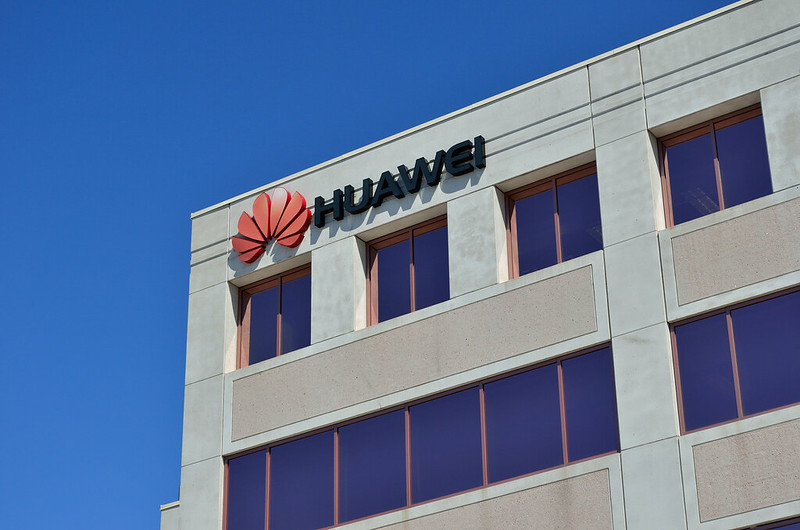Huawei Faces Setbacks in U.S. Courts; Coronavirus Epidemic Expands Beyond Chinese Borders
Lawfare's biweekly roundup of U.S.-China technology policy news.

Published by The Lawfare Institute
in Cooperation With

Huawei Faces Setbacks in U.S. Courts
Huawei has faced setbacks in American courts this month, in two cases that may affect the company’s U.S. reputation. On Feb. 18, Judge Amos Mazzant of the U.S. District Court for the Eastern District of Texas dismissed Huawei’s suit—filed in March 2019—challenging the constitutionality of the National Defense Authorization Act (NDAA). The NDAA includes a provision that bans federal agencies from buying Huawei and ZTE products, as well as from funding or procuring goods from third parties that purchase Huawei’s or ZTE’s goods. In a separate matter, the Department of Justice on Feb. 13 announced three new charges against Huawei and its U.S. subsidiaries. The new Justice Department charges allege racketeering, conspiracy to steal trade secrets, wire fraud and violation of U.S. sanctions against Iran. These charges augment a broad set of claims that the department filed against Huawei in January 2019, which also allege intellectual property theft and sanction violations.
Huawei’s suit against the NDAA argued that the act violates the Constitution’s ban on bills of attainder, or laws that single out individuals for adverse treatment. The suit also alleged material reputational harm from the congressional ban. But Mazzant ruled that the NDAA did not fall under the Constitution’s bill of attainder prohibition, but that it instead reflects “a customer’s choice to take its business elsewhere.” Mazzant also downplayed Huawei’s claims that the NDAA caused material harm, emphasizing that the company can still sell to “every other company and individual in America.”
Analysts never expected that Huawei would triumph. But the outright dismissal, which forestalls a full trial of the case’s merits, deprives Huawei of a public platform to challenge U.S. claims that it poses a national security risk. The outcome may also be prompting some within the company to call for a change in publicity strategy. Huawei USA Security Director Andy Purdy, while still denying that U.S. national security fears have merit, said after the verdict that Huawei needs a “transparency initiative” to help “experts” understand “the facts” about its operations.
Exacerbating Huawei’s problems, the Justice Department’s new Huawei allegations may also affect the company’s image—in fact, some observers believe that was precisely the Justice Department’s intent. The indictment this month alleges extensive wrongdoing by the company over the past two decades, suggesting that a pattern of intellectual property theft has driven Huawei’s success. American lawmakers lauded the Justice Department for calling out Huawei’s business practices—with Senate Intelligence Committee leaders Richard Burr and Mark Warner calling the indictment a “damning portrait of an illegitimate organization.” Huawei, for its part, labeled the indictments an attempt to “irrevocably damage Huawei’s reputation” and to reduce the company’s competitiveness.
While it is not yet certain how either of these two cases will affect Huawei’s approach to public and government relations, Huawei appears likely to escalate its U.S. litigation efforts. Following the new indictment, Huawei denounced the allegations as untrue and predicted the “government will not prevail.” (As of last March, it had pleaded “not guilty” to the Justice Department’s 2019 charges.) And even after the dismissal of its NDAA suit, Huawei affirmed its belief that the NDAA provision violated its “constitutional rights”—though it did not specify what legal options it is now considering.
Recently, Huawei has also taken an offensive approach on other legal matters. On Feb. 6, it filed two lawsuits against Verizon for patent infringements. Huawei, which holds more than 11,000 patents in the U.S., alleged that Verizon had violated 12 trademarks in areas including computer networking and video communications. (Verizon denied the allegations.) Along with ZTE, Huawei also petitioned the Federal Communications Commission (FCC) last December not to designate the two companies as national security threats. The national security threat label would prevent certain FCC funds from being used to purchase the companies’ products.
Huawei’s legal setbacks come even as the company gains acceptance from some U.S. allies. Last month, U.K. Prime Minister Boris Johnson gave Huawei the green light for limited involvement in the country’s 5G network construction. Other European countries, including Germany, appear inclined to follow suit (though France has suggested it will set greater restrictions on Huawei’s involvement). The divergent approaches to Huawei have led analysts to argue that issues surrounding Huawei are causing rifts among Western powers.
Coronavirus Epidemic Expands Outside of China’s Borders, Raising Risk of Global Pandemic
The coronavirus epidemic has spread significantly outside of China’s borders, prompting concerns among experts about a possible global pandemic. A top official at the Centers for Disease Control and Prevention (CDC) warned starkly on Feb. 25 that “it's not so much a question of if” the virus will reach the United States “but rather more a question of exactly when this will happen and how many people in this country will have severe illness.”
At present, cases have been reported in nearly 30 countries, including nations in North America, Europe, Africa and Oceania. Some of the hardest hit countries are South Korea, Italy and Iran, each of which has seen a significant outbreak in the past two weeks. The approaches in these countries to containing the disease provide valuable templates for how divergent health care and political systems mobilize to control—or fail to control—an epidemic.
In South Korea, more than 1,000 cases have been reported, and the disease has spread to every major city in the country. In Daegu, the South Korean city where the coronavirus has spread most, officials have sought to aggressively monitor for infections, and the government has asked citizens to limit their time outdoors. But thus far South Korea has not imposed legal controls requiring Daegu’s citizens not to travel or requiring businesses to close. One possible explanation for the absence of such impositions: Introducing such measures, analysts say, may exceed the government’s authority. South Korea’s strategy to contain the virus thus stands in contrast to China’s approach, which has involved quarantining Wuhan—where the epidemic began—and other cities where infection rates have spiked. Still, citizens in South Korea have taken on their own many of the precautions that Chinese officials imposed by fiat: Many restaurants have required that customers order takeout or for delivery, businesses have asked shoppers to don a mask before entering, and the overwhelming majority of church services have been cancelled. Analysts note that health officials worldwide will be closely monitoring whether Daegu succeeds in controlling the virus, since the Daegu response may provide a model for other democratic countries that cannot clamp down on personal liberties as easily as China.
Italy has confirmed more than 300 cases of coronavirus, prompting Italian officials to impose restrictions on travel and presenting a fresh test for Europe’s open borders. After a series of cases were reported in Lombardy, a region in Northern Italy, Italian authorities locked down a series of towns around Milan—affecting a total population of some 50,000 people—imposing fines for those caught entering or exiting quarantine zones.
The European Commission said Monday that it was not yet considering border closures within Europe’s Schengen zone—an area comprising more than 20 European nations in which travelers can typically move across countries without checks at national borders. But individual EU member states have sprung into action. Austria temporarily closed rail traffic in and out of Italy and has introduced new screening procedures for the coronavirus at entry points. Greece has given wider latitude to officials to conduct tests at ports of entry. France, however, has ruled out any measures to shut down travel from Italy and has also decided not to pursue additional health screenings at airports, decrying both strategies as ineffective. Instead, France has focused on increasing funding for hospitals and readying medical supplies.
But the most worrisome case outside of China has been Iran. The Iranian government announced on Monday that more than 60 people in the country had died from the coronavirus . Analysts worry that the number may be higher because the Iranian government—which actively censors media—may not be providing accurate information about the extent of the outbreak in its reports to the public. Medical professionals in Iran—speaking with Time on the condition of anonymity—expressed the fear that the total number of cases may be much higher. Because Iran serves as a regional hub, the country has emerged as a second focal point for the virus: Coronavirus cases in Iraq, Afghanistan, Bahrain, Kuwait, Oman, Lebanon and the United Arab Emirates have all been traced back to Iran. The World Health Organization called the outbreak in Iran “very worrisome.”
President Trump said in a tweet that American officials have the coronavirus “under control.” He appointed Vice President Pence as head of a new task force to coordinate the government’s response to the virus. The CDC has outlined plans to respond should the coronavirus become an epidemic in the United States: The agency recommends that businesses eschew in-person meetings, that schools consider closing, and that health care facilities stock up on masks and other supplies. But analysts have argued that personnel decisions made by the Trump administration—including eliminating positions for experts on global pandemics within the National Security Council—may weaken the administration’s capacity to respond to the disease. Adding to these concerns, the Washington Post reported on a whisteblower’s complaint alleging that, as part of an initiative to evacuate Americans, the Department of Health and Human Services endangered medical staff by sending them to receive the returning Americans without providing proper equipment or training.
Other News
Senior Trump administration officials will soon meet to discuss further export restrictions against China. Deputies in the administration met earlier in February to review proposals for restrictions, and a Cabinet-level meeting to decide the matter was originally scheduled for Feb. 28. However, officials delayed the meeting amid reports that the issue sharply divides the executive branch. Signs of internal disagreement over new restrictions first emerged after reports this month of Trump officials weighing a ban on General Electric (GE) aircraft-engine sales. Days later, President Trump attacked the proposal, lambasting his regulators for invoking the “always used National Security excuse.” Internally, the Trump administration is split on how export controls would affect national security. Some argue that the move would check China’s technological ambitions, while others maintain that it would undermine American companies’ abilities to innovate. Following Trump’s remarks, officials appear to have ruled out banning GE engine sales, but other proposals remain on the table. Any further restrictions would build on Trump’s partially implemented ban against exports to Huawei from May 2019.
Huawei announced on Feb. 4 that it will set up 5G manufacturing facilities in Europe, with top executives expressing a commitment to servicing European 5G markets. Huawei’s chairman, Liang Hua, clarified later in February that Huawei had begun a feasibility study on European production locations and, while no timeline is set, could open a new factory “very quickly.” The Feb. 4 announcement came a few days after the European Union issued recommendations to its members to permit limited Huawei involvement in domestic 5G network development. Huawei’s push to open a European factory, along with its recent commitment to buy more goods from Europe, signifies its increasing integration into European society and markets. In 2019, Huawei disclosed that it planned over the next five years to purchase $40 billion in components from Europe as an offset to U.S. export controls. Huawei’s choice to build manufacturing capacity in Europe does not come as a surprise. Last December, Huawei founder Ren Zhengfei stated that he hoped to build out 5G manufacturing capacity in Europe, in part to assuage U.S. fears of the company’s close ties to Beijing. In those December comments, Ren also claimed that Huawei would move its “center for research and development” from the U.S. to Canada.
Chinese mobile companies Huawei, Xiaomi, Oppo and Vivo are collaborating on a platform, termed the Global Developer Service Alliance (GDSA), that will let international app developers more easily offer apps on each company’s devices. By uploading apps once to the GDSA, developers will be able to push their apps simultaneously to each company’s app store. The GDSA is widely seen as a bid to challenge the Google Play Store’s global dominance as a mobile-app vendor—although at least one participant company has denied this. Currently, Huawei phones cannot access the Google Play Store or other Google apps. This is due to the U.S. government’s May 2019 export ban against Huawei, which forced Google to bar Huawei from using its apps and services. (Oppo, Vivo, and Xiaomi have all retained access to Google Play.) Shortly following the ban, Huawei leadership stated that the company would not return to the Google ecosystem even if the prohibition were lifted. Huawei mobile phones are popular in Europe and the Middle East, while the Xiaomi, Oppo, and Vivo products have permeated Asian markets. With this level of market penetration among participating companies, the GDSA has the potential to shape consumer access to mobile apps across much of the globe. Reportedly, the GDSA was set to launch in nine regions this March, though the coronavirus outbreak may slow this timeline.
Commentary
In the New York Times, Yi-Zheng Lian argues that cultural views about the healing powers of certain animals and the Chinese government’s habit of punishing messengers both contributed to the coronavirus epidemic. For the Washington Post, Isaac Stone Fish writes that China’s decision to expel three reporters from the Wall Street Journal may have been retaliation for the Trump administration’s move to designate major Chinese news entities as state actors. In Newsweek, Sophie Richardson writes that China’s arbitrary detention of Uighur Muslims may worsen the impact of the coronavirus. For the South China Morning Post, Chauncey Jung argues that Chinese officials have been unsuccessful in their public diplomacy campaigns on Twitter, a platform on which they cannot rely on support from government censors.
For War on the Rocks, Steven Feldstein writes that focusing on China alone will not be enough to curb the rise of digital authoritarianism, the phenomenon in which states use powerful surveillance technology to suppress political rivals or dissidents. For the Council on Foreign Relations, Amy Jaffe explains that the coronavirus may produce an economic downturn that extends far beyond China. In the National Interest, Gordon Chang arguese that the coronavirus exposes vulnerabilities in U.S. supply chains for medical and pharmaceutical goods. For the Taipei Times, Ryan Hass argues that U.S.-China competition over technology may have significant negative impacts on the Taiwanese economy. For Just Security, Reuf Bajrović and Richard Kraemer argue that the United States and the United Kingdom must respond to growing Chinese and Russian influence in the Western Balkans.
For Lawfare, Julianne Smith and Torrey Taussig explore the problems facing the European Union in developing a unified China strategy and propose steps to resolve these problems. In the Fault Lines podcast, hosted on Lawfare, Lester Munson and guests discuss the geopolitical implications of the coronavirus and the U.S. response to it. On the Lawfare podcast, Sophia Yan and Lisa Monaco discuss the Chinese government’s and the Trump administration’s response to the coronavirus and reasons to think the situation will get worse before it gets better.





.jpg?sfvrsn=82a6ee72_5)
